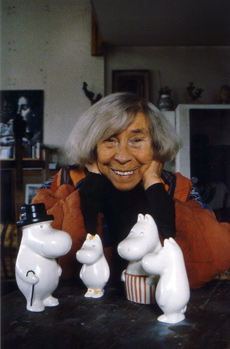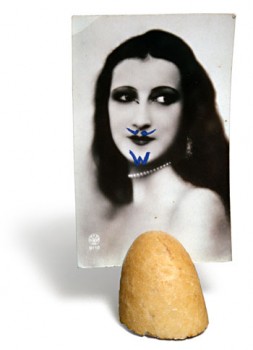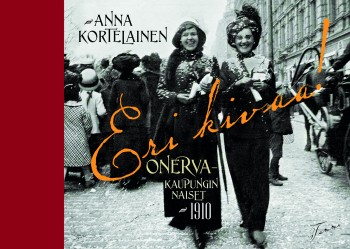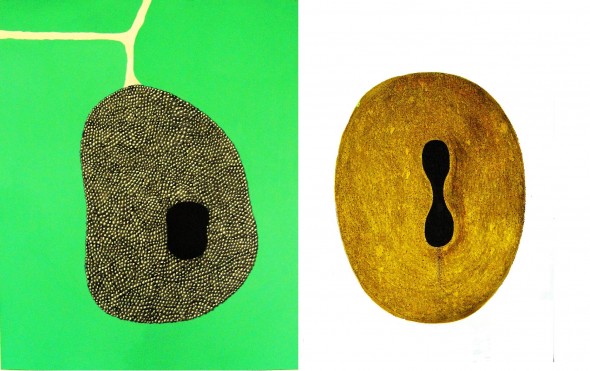Tag: art
The legacy of a self-made man
29 October 2010 | This 'n' that
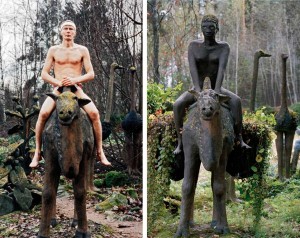
On camelback: in the exotic part of Veijo Rönkkönen’s concrete cosmos there are animals and palm trees, side by side with the living plants of the northerly latitudes. - Photo, left: Veijo Rönkkönen; photo, right: Veli Granö
Some of our readers may remember a story entitled ‘Self-made man’, published in Books from Finland in April 2009: Veijo Rönkkönen, who lived his entire life on a small, isolated farm in eastern Finland, built a garden inhabited by five hundred human and animal figures made of concrete.
Rönkkönen worked in a nearby pulp factory for 41 years. He lived in a small house in the middle of the garden, surrounded by his sculptures, which he had started making in the early 1960s.
Photographer and writer Veli Granö introduced the life and works of this self-made artist in his book Veijo Rönkkösen todellinen elämä / The real life of Veijo Rönkkönen (text in Finnish and English, Maahenki, 2007).
Contemporary folk art in Finland goes by the acronym ITE, from the words itse tehty elämä, ‘self-made life’. The French called it art brut; the English-language term is ‘outsider art’. The artists are ‘unschooled visionaries’ who make their art independent on any societal requirements or definitions.
The sculpture park became the most notable tourist attraction in Parikkala, visited by as many as 26,000 visitors every summer. Rönkkönen, however, refused to turn it into business. He never talked to visitors voluntarily either, but the park was open and free to all. He was awarded a state prize for artistic achievement, the Finland Prize, worth €30,000, in 2007, which he accepted.
Veijo Rönkkönen died last spring at the age of 66. The estate – Rönkkönen’s siblings, living elsewhere in Finland – offered the unique park to the county of Parikkala, which declined the offer because it’s upkeep was estimated to be too expensive.
In October businessman Reino Uusitalo bought the place for €140,000, with the intention of founding an administrative committee for the upkeep of the park. Rönkkönen’s extraordinary ‘total work of art’, will thus stay open – at least until nature – lichen, moss, creepers – claims what it considers it own. 500 sculptures: a self-made man’s open-air art
Hip hip hurray, Moomins!
22 October 2010 | This 'n' that
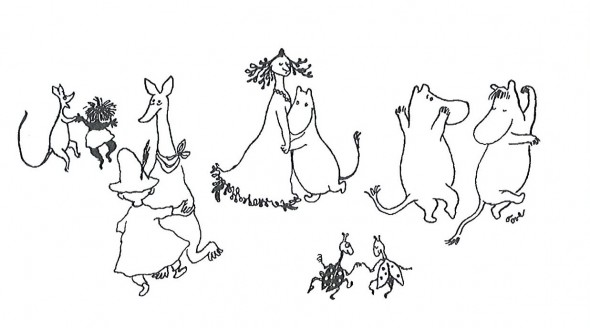
Partying in Moomin Valley: Moomintroll (second from right) dancing through the night with the Snork Maiden (from Tove Jansson’s second Moomin book, Kometjakten, Comet in Moominland, 1946)
The Moomins, those sympathetic, rotund white creatures, and their friends in Moomin Valley celebrate their 65th birthday in 2010.
Tove Jansson published her first illustrated Moomin book, Småtrollen och den stora översvämningen (‘The little trolls and the big flood’) in 1945. In the 1950s the inhabitants of Moomin Valley became increasingly popular both in Finland and abroad, and translations began to appear – as did the first Moomin merchandise in the shops.
Jansson later confessed that she eventually had begun to hate her troll – but luckily she managed to revise her writing, and the Moomin books became more serious and philosophical, yet retaining their delicious humour and mild anarchism. The last of the nine storybooks, Moominvalley in November, appeared in 1970, after which Jansson wrote novels and short stories for adults.
Tove Jansson (1914–2001) was a painter, caricaturist, comic strip artist, illustrator and author of books for both children and adults. Her Moomin comic strips were published in the daily paper the London Evening News between 1954 and 1974; from 1960 onwards the strips were written and illustrated by Tove’s brother Lars Jansson (1926–2000).
Tove’s niece, Sophia Jansson (born 1962) now runs Moomin Characters Ltd as its artistic director and majority shareholder. (The company’s latest turnover was 3,6 million euros).
For the ever-growing fandom of Jansson there is a delightful biography of Tove (click ‘English’) and her family on the site, complete with pictures, video clips and texts.
The world now knows Moomins; the books have been translated into 40 languages. The London Children’s Film Festival in October 2010 featured the film Moomins and the Comet Chase in 3D, with a soundtrack by the Icelandic artist Björk. An exhibition celebrating 65 years of the Moomins (from 23 October to 15 January 2011) at the Bury Art Gallery in Greater Manchester presented Jansson’s illustrations of Moominvalley and its inhabitants.
In association with several commercial partners in the Nordic countries Moomin Characters launched a year-long campaign collecting funds to be donated to the World Wildlife Foundation for the protection of the Baltic Sea. Tove Jansson lived by the Baltic all her life – she spent most of her summers on a small barren island called Klovharu – and the sea featured strongly in her books for both children and adults.
In the beginning was… DNA?
8 October 2010 | Reviews
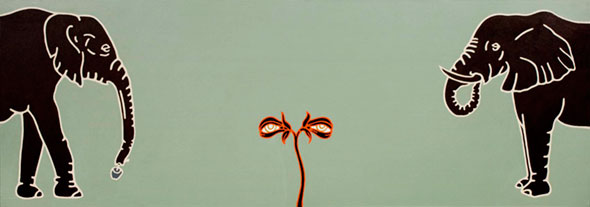
Adam and Eve, or the elephants: Osmo Rauhala’s sketch of The Fall of Man. As the bull eats the apple, evil rises from the ground in the form of a plant with eyes: a ‘misbreed’, a cross of two species alien to each other
Kuutti Lavonen – Osmo Rauhala – Pirjo Silveri
Tyrvään Pyhän Olavin kirkko – sata ja yksi kuvaa /
St Olaf’s Church in Tyrvää – One Hundred and One Paintings
Toim. / Edited by Pirjo Silveri
Translations: Silja Kudel, Jüri Kokkonen
Helsinki: Kirjapaja, 2010. 143 p., ill.
ISBN 978-952-247-103-1
€44.30, hardback
The old shingle roof of the early 16th-century stone church of St Olaf in Tyrvää, in the province of Pirkanmaa, southern Finland, was repaired by village volunteers in 1997. Three weeks after they completed their work, a drunken arsonist set the church on fire. More…
Paris, je t’aime
7 May 2010 | This 'n' that
‘Paris traverse la pensée comme une encyclopédie de la vie, où l’on découvre des passages, des cours intérieures, des ruelles et des autoroutes, toujours plus surprenants. La ville ne se vide ni n’abandonne jamais, n’accorde ni ne refuse.’
‘Paris permeates your mind like an encyclopaedia of life in which you will incessantly discover astonishing new passages, courtyards, alleys and avenues. It will never either run empty or surrender, it won’t admit or refuse.’
L’air de Paris / Pariisin tuoksu (‘Air of Paris’, Musta Taide, 2009) is an elegant little book that features artwork by Ismo Kajander and texts by Anna Kortelainen relating to the mother city of all artists. More…
Ihmisten eläinkirja. Muuttuva eläinkulttuuri [The people’s book of animals. Our changing relationship with the animal kingdom]
22 April 2010 | Mini reviews, Reviews
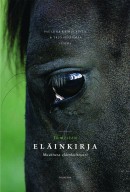 Ihmisten eläinkirja. Muuttuva eläinkulttuuri
Ihmisten eläinkirja. Muuttuva eläinkulttuuri
[The people’s book of animals. Our changing relationship with the animal kingdom]
Toimittaneet [Ed. by]: Pauliina Kainulainen & Yrjö Sepänmaa
Helsinki: Gaudeamus Helsinki University Press. 235 p., ill.
ISBN 978-951-570-786-4
€ 31, paperback
This book adopts a multidisciplinary approach in its examination of the relationship between humans and animals, highlighting historical, ethical and philosophical connections. The authors include humanists, theologians, anthropologists and artists. They address issues such as animal and nature conservation, animal breeding and husbandry, attitudes towards animals in myth and religion, and depictions of animals in Finnish art. Humans’ relationship to animals can hardly be said to have been consistent: in some religions, certain animals were worshipped as gods, whereas others viewed them as symbols of evil. We treat our pets as members of the family, while livestock animals are subjected to more and more cost-effective production methods. The architect Juhani Pallasmaa introduces readers to the master architects of the animal world and their highly refined, diverse architectural solutions, from which people have learnt a great deal.
Women and the city
17 April 2010 | This 'n' that
How was city life for the single woman a hundred years ago in Helsinki?
She could ride a bike, for example, provided it was equipped with an ‘alarm system’ and the speed was not high. Socially she could have fun as long as she obeyed the rules. No admittance to restaurants without male company, for example.
Some young women in those days had to make a living by teaching or by working in an office – before they got married, of course.
A new exhibition (25 March–29 August) at Helsinki’s Ateneum art museum, entitled Kaupungin naiset (‘Women of the city’), focuses on the cultural life of young women in Helsinki in the 1910s through the eyes of the writer and critic L. Onerva (aka Hilja Onerva Lehtinen, 1882–1972). More…
Green thoughts
Extracts from the novel Kuperat ja koverat (‘Convex and concave’, Otava, 2010)
I decided to go to the Museum of Fine Arts.
After paying for my entrance ticket, I climbed the wide staircase to the first floor. There all I saw were dull paintings, the same heroic seed-sowers and floor-sanders as everywhere else. Why were so many art museums nothing more than collections of frames? Always national heroes making their horses dance, mud-coloured grumblers and overblown historical scenes. There was not a single museum in which a grandfather would not be sitting on a wobbly stool peering over his broken spectacles, interrogating a young man about to set off on his travels, cheeks burning with enthusiasm, behind them the entire village, complete with ear trumpets and balls of wool. The painting’s eternal title would be ‘Interrogation’ and it would be covered with shiny varnish, so that in the end all you would be able to see would be your own face.
I climbed up to the next floor. All I really felt was a pressing need to run away. No Flemish conversation piece acquired in the Habsburg era was able to erase a growing anxiety related to love. More…
Konstnärsbröderna von Wrights dagböcker 1–7 [The diaries of the von Wright brothers, Vols. 1–7]
1 April 2010 | Mini reviews, Reviews
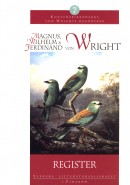 Konstnärsbröderna von Wrights dagböcker 1–7
Konstnärsbröderna von Wrights dagböcker 1–7
[The diaries of the von Wright brothers, Vols. 1–7]
Magnus von Wright: Dagbok [Diary] 1824–1834. 407 p., ill. ISBN 951-583-026-5
Magnus von Wright: Dagbok [Diary] 1835–1840. 470 p., ill. ISBN 951-583-040-0
Magnus von Wright: Dagbok [Diary] 1841–1849. 431 p., ill. ISBN 951-583-047-8
Magnus von Wright: Dagbok [Diary] 1850–1862. 496 p., ill. ISBN 951-583-060-5
Magnus von Wright: Dagbok [Diary] 1863–1868. 493 p., ill. ISBN 951-583-085-0
€ 46 each, hardback
Wilhelm & Ferdinand von Wright: Dagböcker [Diaries] 615 p., ill. ISBN 978-951-583-137-8.
€ 46, hardback
Index: 398 p., ill. ISBN 978-951-583-138-5. € 20, hardback
Helsinki: Svenska Litteratursällskapet i Finland, 1996–2010
Toimittaneet [Ed. by]: Anto Leikola, Juhani Lokki, Torsten Stjernberg, Johan Ulfvens
The three von Wright brothers, who came from a family with nine children in rural north Savo (in eastern Finland), shared a talent for meticulous observation combined with masterful technique and a romantic style. Each of these artists, who were active during the Biedermeier era, was a trailblazer in his own field: Magnus (1805–1868) as a proponent of Finnish national art, Wilhelm (1810–1887) as a wildlife illustrator, and Ferdinand (1822–1906) as a painter of landscapes and birds. Their contribution to Nordic ornithology is considerable. The index volume to the von Wright brothers’ diaries (which were written in Swedish) includes lists of their artworks and details of works held by collections abroad. This series is of significant cultural importance, and it is remarkable for its scientific accuracy. Five volumes consist of Magnus von Wright’s diary entries, which he wrote daily from 1820 up until his death. The sixth volume contains diary entries by the two younger brothers, which provide insights into the everyday life and society of that era, as well as the artists’ working practices and their relationship with nature.
Jaakko Heinimäki & Juha Metso: Miina – Äkkijyrkkä
6 November 2009 | Mini reviews, Reviews
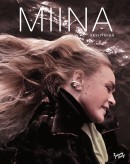 Miina – Äkkijyrkkä
Miina – Äkkijyrkkä
Text: Jaakko Heinimäki
Photos: Juha Metso
Helsinki: Johnny Kniga Kustannus, 2009. 190 p., ill.
ISBN 978.951-0-35552-7
€41, hardback
Miina Äkkijyrkkä (born 1949; real name Riitta Loiva) is a Finnish artist known for her cattle-themed paintings and sculptures. Äkkijyrkkä is also widely known as a passionate supporter and breeder of Eastern Finncattle, an endangered breed native to Finland. Most of the accompanying texts in this book which describe her ideas and her art come from a series of discussions with author and Lutheran minister, writer Jaakko Heinimäki, recorded in the spring of 2009. Miina Äkkijyrkkä speaks openly about her art and the diverse phases of her life, her values and faith, and her clashes with the authorities and the rest of society. This book is magnificently illustrated with Juha Metso’s photographs, which were taken over a period of 15 years in Finland and abroad. More information about the artist and her works is available here.
Marita Liulia: Choosing My Religion – Uskontoja jäljittämässä
30 July 2009 | Mini reviews, Reviews
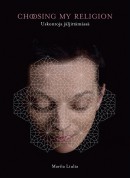 Choosing my Religion – Uskontoja jäljittämässä
Choosing my Religion – Uskontoja jäljittämässä
Käännökset englanniksi [English translations]: Michael Garner
Helsinki: Maahenki, 2009. 223 p., ill.
ISBN 978-952-5652-61-1
€ 38, hardback
Marita Liulia is a visual artist who specialises in interactive media art. Her works have been shown in more than 40 countries. Choosing my Religion discusses the nine major religions of the world. It contains 150 pictures and photographs, as well as texts by the artist and an article by associate professor of comparative religion Terhi Utriainen. The book, like the exhibition at Helsinki’s Kiasma museum which it accompanies, focuses on the religions and on animism. Liulia has travelled in 50 countries, studying religions and discussing them with both scholars and laymen. Her project concentrates on the possibilities of equal choice between religions and emphasises their positive aspects. The subject of the photographs in the book is the artist herself, who abandoned her Christian faith as a teenager. As a child she suffered from rheumatoid arthritis, and was unable to walk until she was 15. Liulia has portrayed herself in the traditional dress and emblems of the different faiths. In her view one of the features uniting all religions is the fact that in them women play the role of servants who pass on the faith to succeeding generations. Choosing my Religion comprises the book, the (touring) exhibition and a website.
Self-made man
1 April 2009 | Extracts, Non-fiction
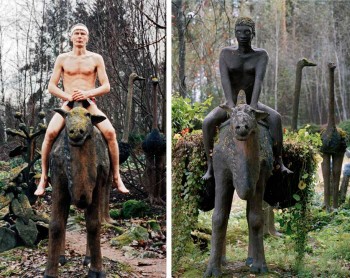
On camelback: in the exotic part of Veijo Rönkkönen’s concrete cosmos there are animals and palm trees, side by side with the living plants of the northerly latitudes. - Photo, left: Veijo Rönkkönen; right: Veli Granö.
Extracts and photographs from Veijo Rönkkösen todellinen elämä / The real life of Veijo Rönkkönen (Maahenki, 2007. Translation: Kirsti Nurmela-Knox)
Veijo Rönkkönen (born 1944) has lived all his life on an isolated, small farm in eastern Finland, Parikkala, less than a kilometre from the Russian border, where he has quietly built a garden inhabited by nearly five hundred human figures made of concrete. Entrance is free.
In the mirror
Issue 3/2003 | Archives online, Fiction, Prose
Extracts from the novel Helene (WSOY, 2003). Introduction by Leena Ahtola-Moorhouse
It was raining that day, and I was leafing through art books, as I often do, in the bookshop. Then I happened to pick up a work in which there was a picture; a bowl of apples, one of which was black.
Stories often begin like this, inexplicable as deep waters, secret as an unborn child which moves its mouth in the womb as if it wished to speak. For people do not seek mere understanding… people seek the sulphurous, tumultuous shapes of clouds; people seek bowls of apples of which one is black.
I bought the book and made an enlargement of the still life; on the wall, it was even more remarkable, for its correct position was standing up, tête à tête, looking straight at you, unblinking.
The apples seemed to move, to speak. I began to ponder them more and more. In the end I had to read everything I could lay my hands on about the still life’s painter. I had to visit Hyvinkää, where she lived for a long time, and touch her tree in Tammisaari with my hand. I had to travel as far as Brittany to see the rugged landscape that meant so much to her. More…
A level gaze
Issue 3/2003 | Archives online, Articles, Non-fiction
The artist Helene Schjerfbeck created her own form of modernism, giving pride of place to emotion, writes Leena Ahtola-Moorhouse. Throughout her solitary life, permanently affiicted by a physical handicap resulting from a childhood accident, Schjerfbeck looked into the mirror for inspiration. In her novel Helene the author Rakel Liehu takes a look at Schjerfbeck’s mirror images and the painter’s long life
Helene Schjerfbeck (1862–1946) was passionately interested in human beings and their inner lives – the riddle of the face.
She was one of the few artists of her generation who both created masterpieces in the naturalistic and impressionistic style of her youth and was also able to shift to an entirely modern, expressionist mode. Intensity and control only increased in the avant-garde paintings of her late period. These bear comparison with the work of Picasso, Modigliani and Rouault. More…
A smell of the sea
Issue 1/2000 | Archives online, Fiction, poetry
Poems from Namnet på tavlan Klee målade (The name of the picture Klee painted’, Schildts,1999; Kleen taulun nimi, Otava, 1999; Finnish translation by Jaakko Anhava). Introduction by Hannu Väisänen
Old harmony
You see an old street and stop outside a gate to a shadowy inner courtyard. An oak tree grows there, its crown stretches towards the light. How big it is! On a bench underneath it an old couple sit looking at you. They are trying to discover what you once were. Beside them lies an old lute, like a large, gleaming fruit. You go over to it, pick it up, play a chord. The old woman and the old man look at you without surprise. It has all happened once before, after all. Not much more is needed, only a deep silence. The oak tree murmurs, the old couple have gone, you sit there with your wife and see someone entering the courtyard. Do we know him, you say. But scarcely have you finished your question than the courtyard is empty again, a moment in eternity. More…

